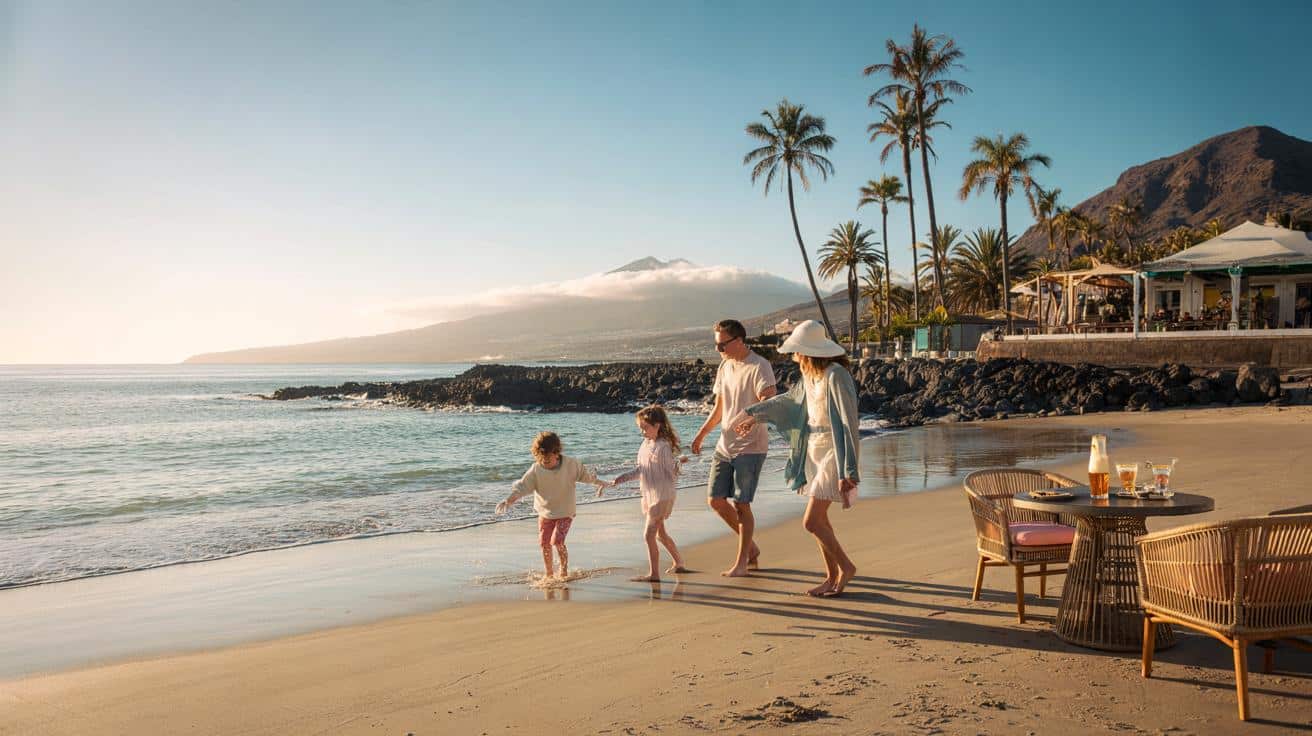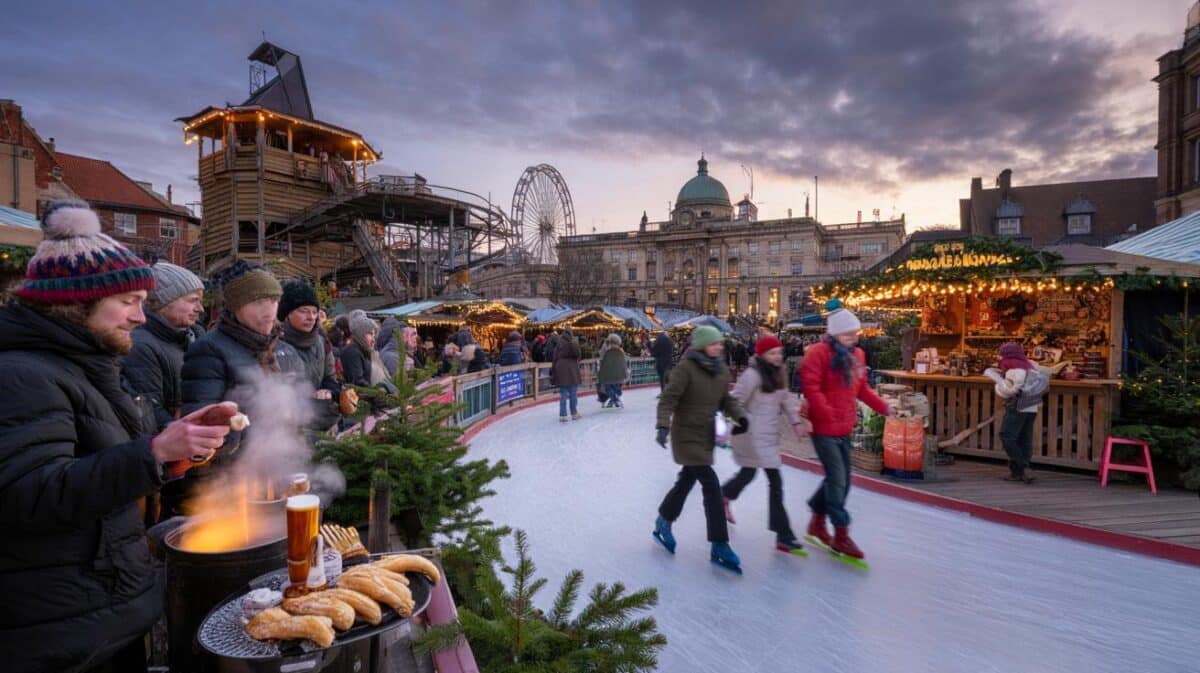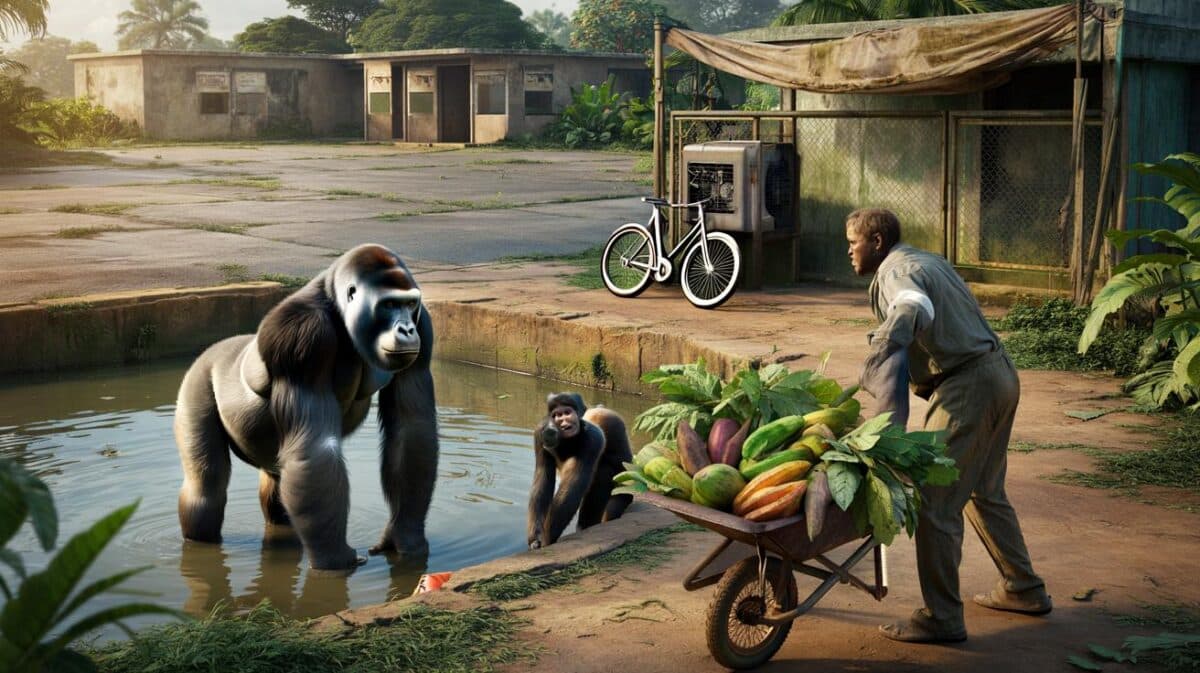You want warmth you can bank on, not a maybe. Europe has one place that delivers the real thing, straight through winter.
By midday the kitchen light feels blue. The kettle hisses, you wrap your fingers round a mug and stare out at trees doing their bare best. On your phone, a map zooms down past Lisbon and Morocco, to a sunlit bump in the Atlantic. Four and a half hours from Gatwick. A promise of 21°C in January, and that gentle, salt-licked breeze people rave about in group chats.
Later, a plane door opens and the air smells faintly of warm stone and aloe. Palm fronds tick the edges of the runway. You peel off a jumper and it’s like stepping through a curtain into another season. *This is where winter loosens its grip.*
There’s a trick to it.
Why this island keeps winning winter
There’s a reason travellers keep pointing their compass to **Tenerife** when the rest of Europe reaches for thermal socks. The island sits at 28°N, snuggled into the mild Canary Current and sheltered by the Teide massif. Down south, around Costa Adeje and Los Cristianos, a reliable rain shadow turns most days into T‑shirt weather, even when Madrid is shivering.
On Playa del Duque one recent January afternoon, a family from Leeds quietly shed their coats like snakeskins. Two kids chased warm waves while their parents nursed cortados at a chiringuito, grinning at the thermometer pinned to the bar: 22°C at 2pm, light breeze, zero clouds. The stats back the smiles. South Tenerife averages 20–23°C daytime highs in winter, around 6–7 hours of sunshine, and sea temperatures hovering near 20°C. Flights from the UK hover around £80–£160 return if you dodge Christmas week.
It isn’t magic. It’s microclimate. Mount Teide, Spain’s highest peak, blocks Atlantic fronts and creates a dry, sunny leeward zone on the southwest coast. Trade winds do the rest, keeping the air fresh and the skies scrubbed clear. If a day starts grey, it often burns blue by late morning. That’s why hotels perch on that sun line from La Caleta to Los Cristianos. The weather patterns have made the decision for decades.
How to play a short winter escape like a local
Pick a southern base and set your day by the light. Mornings are gold for the beach: 10am to 1pm is when the sand glows and the sea is calmest. After lunch, swap the lounger for a coastal stroll to Playa del Bobo or a dip in the natural pools at Los Gigantes. Late afternoon, drive 30 minutes into the hills for warm light over banana terraces and volcanic cones. That’s your golden hour.
We’ve all had that moment when a holiday bags you, not the other way round. Don’t overpack jumpers, don’t book the lush north if your soul craves sun every hour, and don’t ignore the UV just because the air feels kind. Let’s be honest: nobody actually re-applies sunscreen every two hours on the dot. Do it once more than you think you need to, and you’ll thank yourself at dinner.
On rare calima days, when Saharan dust drifts in and the air goes hazy, swap beach time for cool laurel forests in Anaga or a tapas crawl in La Laguna. A local guide summed it up neatly:
“Follow the island’s mood. If the coast is sleepy, the mountains are wide awake. There’s always a sunny pocket somewhere.”
- Best winter-sun bases: Costa Adeje, La Caleta, Los Cristianos.
- Good-weather activities: whale watching off Los Gigantes, Teide sunset, coastal path to El Duque.
- Backup plan: Anaga hiking, Santa Cruz street cafés, La Orotava patios.
What makes the sunshine feel different here
The warmth isn’t a furnace blast; it’s easy, liveable heat. You can walk the clifftops without wilting, then plunge into a rock pool and wander straight to dinner. That gentle Atlantic light turns buildings honey-soft and gives photos a filmic, not-filtered look. It’s why so many visitors come home with pictures that don’t need fixing.
Food anchors the mood. Order papas arrugadas with red and green mojo and a grilled vieja fish, and the day slows down on its own. At a guachinche in the hills, a plate of slow-cooked pork arrives with local wine and the conversation unknots. The island leans into simple pleasures, and in winter those feel bigger.
There’s also the drama you can dip into, or not. Teide’s lunar slopes are an hour from the beach, and the stargazing is world-class thanks to the Starlight Reserve skies. One evening you’ll be in flip-flops watching pilot whales breach; the next you’re above the cloud deck at sunset, a scarf around your neck, watching the volcano cast a perfect triangle shadow into infinity. **Winter sun** with a storyline.
Logistics are blessedly simple. Direct flights from London, Manchester, Dublin, Paris, Amsterdam and dozens more European cities land daily. The airport transfer to the southern resorts is 20–30 minutes. Car hire is inexpensive, roads are clear, and the island’s loop makes day trips easy. It’s the rare winter trip where spontaneity actually works.
Money stretches further if you play it smart. Avoid the Christmas–New Year spike and February half-term, and you can snag midweek returns for under £120 and sea-view apartments from £70 a night. Eat where the chalkboard menu is in Spanish first. Tapas plates, fresh fish and a jug of barraquito for far less than resort prices. A little planning, a lot of sunshine.
Families find their rhythm fast. Shallow coves like Playa de las Vistas stay calm, lifeguards are present, and promenades are pram-friendly. Teenagers can learn to surf in El Médano’s gentle winter swell while grandparents linger over coffee two benches away. Everyone meets somewhere sunny in the middle. That’s rare and valuable when daylight is short back home.
The south gets the headlines, but the north brings soul. Santa Cruz feels like a proper Spanish city with winter festivals, modern art at TEA, and pavement tables where you can chase the sun across a square. La Laguna’s pastel mansions and wooden balconies glow in late light. When the south naps, the north stories.
Nature doesn’t clock off in winter. The Atlantic is calm, visibility for snorkelling is good, and humpback and pilot whales patrol the deep-water channel off Los Gigantes year-round. Book a small-boat operator with a sustainability badge, and you’ll likely see fins slice the water against those 600‑metre cliffs. It’s a quiet thrill that lingers longer than a tan.
On the rare cool day, tilt the itinerary. Coffee in Garachico, then a ramble through black-lava lanes to natural pools that steam gently in the morning sun. A late lunch in Icod de los Vinos, a quick peek at the dragon tree, and back down to the coast in time to watch surfers catch the last set. Your coat stays in the wardrobe. **A no‑fuss escape** in practice.
What you bring home isn’t just colour in your cheeks
Some trips fade the second you close the front door. This one leaves a trace in your routine. You start opening the blinds a bit earlier, as if the light might carry on. You think of a midday swim while queuing for a sandwich and feel oddly calm about the rain.
Maybe that’s the secret of Europe’s best winter-sun fix. It doesn’t shout. It nudges. The weather is kind, the days are easy, and the island gives you just enough drama to remember without the stress of chasing it. Share it with someone on a grey Tuesday and watch their face change.
| Point clé | Détail | Intérêt pour le lecteur |
|---|---|---|
| Sun reliability | Southwest coast averages 20–23°C and 6–7 sunshine hours in winter | Maximises the chance your short break is genuinely warm |
| Easy access | 4–4.5 hours from the UK/Western Europe, short transfer times | Less travel faff, more time on the beach |
| Mix of moods | Beaches, volcano sunsets, whale watching, historic towns | Everyone in the group gets a “best bit” |
FAQ :
- When’s the sweetest winter month for sun?January and early March are a sweet spot for calm, bright days and softer prices. December brings festive buzz, February has half-term crowds. Aim midweek for quieter beaches.
- Is the sea warm enough to swim?Yes. Expect around 19–20°C in winter. It’s refreshing rather than tropical, and rock pools warm up nicely by midday. Many hotels also heat their pools.
- Can I do it on a budget without it feeling scrimped?Absolutely. Fly midweek, choose an apartment in Los Cristianos or La Caleta, eat at guachinches, and book small-group excursions directly. You’ll save and keep the experience local.
- What if the calima dust blows in?Swap coast time for the north’s forests and city cafés, visit museums in Santa Cruz, or chase clear pockets around El Sauzal. The haze usually passes within a day or two.
- Do I need permits for Mount Teide?The cable car needs a ticket, and the very top crater requires a free but limited permit booked weeks in advance. No permit? Hike to viewpoint trails like Pico Viejo for big-sky drama without the paperwork.








